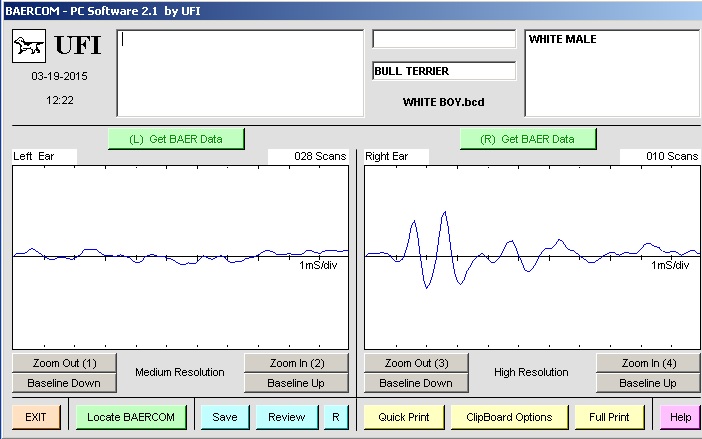The hearing test known as the brainstem auditory evoked response or BAER detects electrical activity in the inner ear and the auditory pathway in the brain. The ear is being stimulated through a series of clicks delivered through headphones placed over the dogs ear and the response is recorded on a device as a wave with several peaks. A white (masking) sound is used on the other ear to prevent interferences.
The first peak is formed in the inner ear while the following are formed in the brain. In dogs or cats with congenital deafness the defect appears in the inner ear so all the peaks are missing.
The BAER test is done once in a lifetime and each dog receives a certificate after the test. The results can be normal hearing, unilateral deafness (deaf in one ear) or bilateral deafness (deaf in both ears).
Congenital deafness is a recognised problem in animals carrying the piebald gene (white coated breeds: Bull Terrier, Samoyed, Greyhound, Great Pyrenees, Sealyham Terrier, Beagle, Bulldog, Dalmatian, English Setter) or merle gene (merle coat colour: Collie, Shetland Sheepdog, Dappled Dachshund, Harlequin Great Dane, American Foxhound, Old English Sheepdog, and Norwegian Dunkerhound) and those with blue eyes (blue iris). In these animals the congenital deafness develops in the first few weeks after birth while the ear canal is still closed, usually resulting from the degeneration of part of the blood supply to the inner ear. The cause of this degeneration is unknown.
A full list of breeds affected by congenital deafness can be found here.
A very good explanatory article about genetics and inheritance of canine deafness can be found on the website of the American Orthopaedic Foundation for Animals.
Hearing test from a dog with unilateral deafness. You can see the trace from the left ear missing the normal peaks, this dog being deaf in its left ear. The right ear was normal.

A white French Bulldog with one blue eye. This lovely girl was deaf in her left ear.